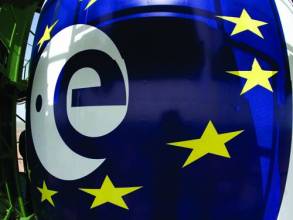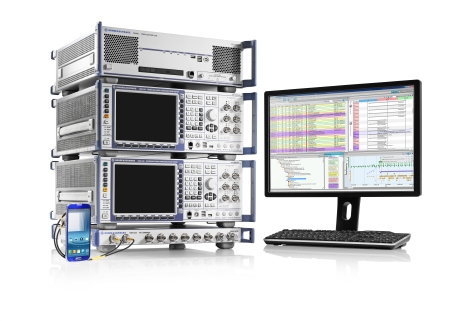A paraphrase of Julius Caesar may be in order here: “Galileo est omnis divisa in partes tres.” Because, as with any global navigation satellite system, Galileo as a whole is divided into three main parts: the political, the infrastructural, and the user application marketplace.
A paraphrase of Julius Caesar may be in order here: “Galileo est omnis divisa in partes tres.” Because, as with any global navigation satellite system, Galileo as a whole is divided into three main parts: the political, the infrastructural, and the user application marketplace.
Developments over the past year — and past month — have markedly rearranged the progress and prospects of all three. Political concerns are subsiding (though not disappearing), building the space and ground segment under a public procurement is finally and irrevocably under way, and the locus of concern is shifting to matters involving market development and industry’s impatience to begin designing, manufacturing and selling Galileo-capable user equipment.
Until final approval of the program’s €3.40-billion by the Transport Council and Parliament last spring, the political realm — encompassing such issues as policy, funding, institutional relations — had dominated the 15-year-old conversation on Europe’s GNSS initiative.
The dynamics of a 27-nation association stretching from the North Sea to the Aegean ensure that political issues will remain prominent, including such matters as a Galileo cooperation agreement still to be completed between the European Space Agency (ESA) and the European Commission (EC). But replacement of the public-private partnership (PPP) approach, final budget authorization, and passage of a new regulation on Galileo has resolved most of the roadblocks and removed much of the doubt surrounding the program.
FOC Procurement Begins
Last July’s launch of the procurement process to complete a fully operational capability (FOC) Galileo has the program moving ahead. Although running slightly behind schedule, the September 19 announcement of candidates selected to compete as prime contractors for Galileo’s six infrastructure work packages has advanced the process to the rather novel “dialog” phase, with final contracts expected to be signed early next year.
In a September 19 announcement, the European Commission (EC) and the European Space Agency (ESA) said they had chosen the candidates out of 21 applicants in the initial phase of the procurement procedure.
Following an invitation issued July 1, interested parties submitted a “Request to participate.” Candidates were shortlisted on the basis of pre-defined selection and exclusion criteria. Marco Falcone now serves as the system and operations manager for ESA’s Galileo Project Office.
Candidates were named in six areas of work or “work packages” — System Support: ThalesAleniaSpace, Italy, and Logica (Netherlands); Ground Mission System: ThalesAleniaSpace (France) and Logica (United Kingdom); Ground Control System: Astrium (UK) and G-Nav grouping represented by Lockheed Martin IS&S (United Kingdom); Space Segment (Satellites): Astrium (Germany) and OHB System (Germany); Launch Services: Arianespace (France); Operations: Nav-up grouping represented by Inmarsat (UK), and DLR (German Aerospace Center) and Telespazio (Italy).
EU officials say the next step of the procurement procedure — a dialog phase — will take place over the next 15 to 30 weeks. ESA will manage the process as the delegated procurement agent, in close coordination with the EC as contracting authority.
As the first step, candidates will be required to deliver a first iteration of their proposal in relation to the work package(s) for which they will bid. The initial dialog meetings will proceed on the basis of the contents of these preliminary proposals.
After those discussions, ESA will provide to candidates a detailed set of documents, including technical management and contractual requirements, in response to which the companies will submit “refined proposals” with updated tender documentation and more precise information.
At a certain point, ESA will close the dialog phase for a given work package and invite the candidates to submit their “best and final offers,” with a final selection, award, and signature following within eight weeks, according to the nominal timeline established by the EC and ESA.
If the European agencies can stick to their schedule, that would place the final award of the FOC contracts sometime between early March and late May 2009. However, the nominal contracting timeline, which called for a seven-week selection phase to choose the short list of companies, ran nearly a month late. Under the current schedule for the public acquisition of Galileo’s ground and space infrastructure, four in-orbit validation (IOV) spacecraft will be launched beginning in 2010 with the full 30-satellite constellation in place by 2013.
Cancellation of the overall contract to build the four in-orbit validation (IOV) satellites and renegotiation of terms with subcontractors has pushed the scheduled launch of the first IOV spacecraft into 2010.
GIOVE-B Returns to Service
After being off-line for a couple of weeks, apparently due to space radiation, Galileo’s GIOVE-B satellite began transmitting again on September 25. According to ESA spokespersons, the spacecraft stopped operating between September 9 and September 24, entering automatic shutdown mode in order to protect delicate circuitry.
Although generally a rare event, cosmic rays can affect satellites adversely. Part of the IOV satellites’ mission is to test and qualify the electronics systems design in preparation for construction of the FOC Galileo spacecraft.
EGNOS Nears Completion
New financial commitments will support an operational status next spring for the European Geostationary Navigation Overlay Service (EGNOS) — a satellite-based augmentation system that was once known as GNSS 1 in the European satnav program.
Paul Verhoef, head of the rapidly expanding Galileo unit in the EC Directorate-General for Energy and Transport (DG-TREN), says that certification for aviation use of the system should occur by the end of next year. The EC is in the process of selecting an EGNOS service provider who will operate the system through 2013. October 15 was the deadline for companies to respond to a call for tenders to provide EGNOS service.
About 70 percent of the flights in Europe today are made with aircraft equipped with GPS/RAIM-capable receivers, said Francisco Salabert of Eurocontrol’s GNSS policy office, referring to the equipment’s use of receiver autonomous integrity monitoring.
More Interest Brings New Frustrations
Breaking the long-standing political and infrastructural logjam — with the likelihood of a significant availability of additional modernized signals within a couple of years — has stimulated renewed interest and activity among equipment manufacturers and would-be Galileo/GNSS service providers — what’s known in Europe as the “downstream industry.”
Just in time to intersect with the FOC procurement process, the EC appears to have sorted out its position on the participation of companies from non-European companies in the Galileo FOC procurement. (Canada, as an associate member of ESA, represents an exception to the EU-only provision.)
Except for components incorporating classified information and technologies, the prime contractors for the six work packages — which must have their headquarters in nations directly sponsoring Galileo — will be able to purchase goods and services from foreign companies.
Aside from that, another consideration that may limit foreign companies are the so-called ITAR restrictions — International Traffic in Arms Regulations — that in the case of U.S. firms requires approval from the State Department to export certain products or technical information.
In an interview with Inside GNSS, Verhoef referred to this as a matter of “security of supply” with potential delays caused by the ITAR rules. “All things being equal,” Verhoef said, “if one company has an ITAR risk associated, I’d go with the other company.”
Verhoef’s comment prompted a follow-up question: what are the specifics of the EC/ESA relationship in which ESA is the Galileo design authority and is also charged with conducting the acquisition process?
“ESA makes the judgment on the technical side,” Verhoef said. “We come in on policy-related questions” that may arise.
The EC’s DG-TREN is building up its capacity to participate in this process, bringing over about 30 staff members from the European GNSS Supervisory Authority (GSA), the agency that had been charged with supervising the industry consortium and contract once envisioned under the PPP model. Eventually, these and other staff members will comprise a third unit under Verhoef’s direction.
Not-So-Merrily Downstream
Resolution of issues in the other two areas leads finally to the increasingly controversial matter of commercial development of user equipment and services. Chief among the related concerns is the completion and release of a final Galileo open service (OS) interface control document (ICD) and the terms under which companies can use the ICD to build and sell equipment commercially.
In a panel discussion on the subject at the September 16 meeting of the Civil GPS Service Interface Committee (CGSIC), Verhoef joined Ed Morris, director of the U.S. Department of Commerce’s Office of Space Commercialization; Mike Swiek, executive director of the U.S. GPS Industry Council, and John Pottle, director of marketing for Spirent Communication’s GNSS simulator business.
Verhoef and Morris cochair a working group established under the 2004 GPS/Galileo cooperation agreement signed by the United States and the European Union. That agreement calls for a “non-discriminatory approach,” which allows U.S. and European companies to build GPS- and Galileo-capable equipment.
However, although the GPS ICD and updates are available without restraints on commercial development, the draft ICD for Galileo’s open service, released in 2006 and updated earlier this year, prohibits use of the Galileo ICD’s specifications for commercial purposes. Although the draft specs can be used for research and development, only companies that have developed products under ESA or EC contracts can sell their equipment — and then only to agencies and companies involved with the Galileo program.
That may change for simulator manufacturers in the near future. In a plenary speech at the U.S. ION GNSS 2008 conference in Savannah, Georgia, Verhoef said, “The U.S. Government [with all due lobbying from U.S. industry] has recently made a proposal to release the sales of Galileo OS simulators developed under ESA contracts for testing purposes. In the coming weeks I will get a response to Ed Morris, but let me say that we are considering it very seriously in the spirit of boosting the market.”
That could be accomplished, Verhoef subsequently told Inside GNSS, by changing “the legal text on the first page of the ICD” exclude simulators from the constraints on commercial developments.
Not by Simulators Alone
When it comes to Galileo receiver development, however, the situation is more problematical for companies. Morris said that a second meeting of the US/EU working group on trade issue in July considered proposals for enabling equipment manufacturers to develop and build GPS/Galileo receivers on a level playing field.
Verhoef described the EC’s stance on the subject as “rather conservative,” and proceeding on a “step-by-step basis.” But uncertainty about the timing and elements of a final decision on commercial use of a final ICD is frustrating the downstream industry, which says it cannot size the risk of investing in Galileo user equipment development without knowing all the full dimensions of potential costs.
In the CGSIC panel discussion, Swiek cited unresolved issues involving intellectual property rights (IPR), commercial licenses, user fees, simulator availability, and the fear of a “closed club of Galileo-favored companies.
Although some technical issues remain to be worked out, based on the results of tests conducted using the experimental GIOVE-A and –B spacecraft now in orbit, the main obstacle to releasing a commercially usable ICD is the possibility that the EC may try to put a PPP in place to operate Galileo once the system infrastructure has been built.
“If you’re talking about a system that a future operator needs to opportunity to make money on,” Verhoef said, “it would be silly to rule out some of these options,” such as licenses, taxes on Galileo equipment, and user fees.
Verhoef added that “next year around this time we will be able to provide a lot more product and stability in the deliverables,” referring to the Galileo ICD and policies on commercial development.






